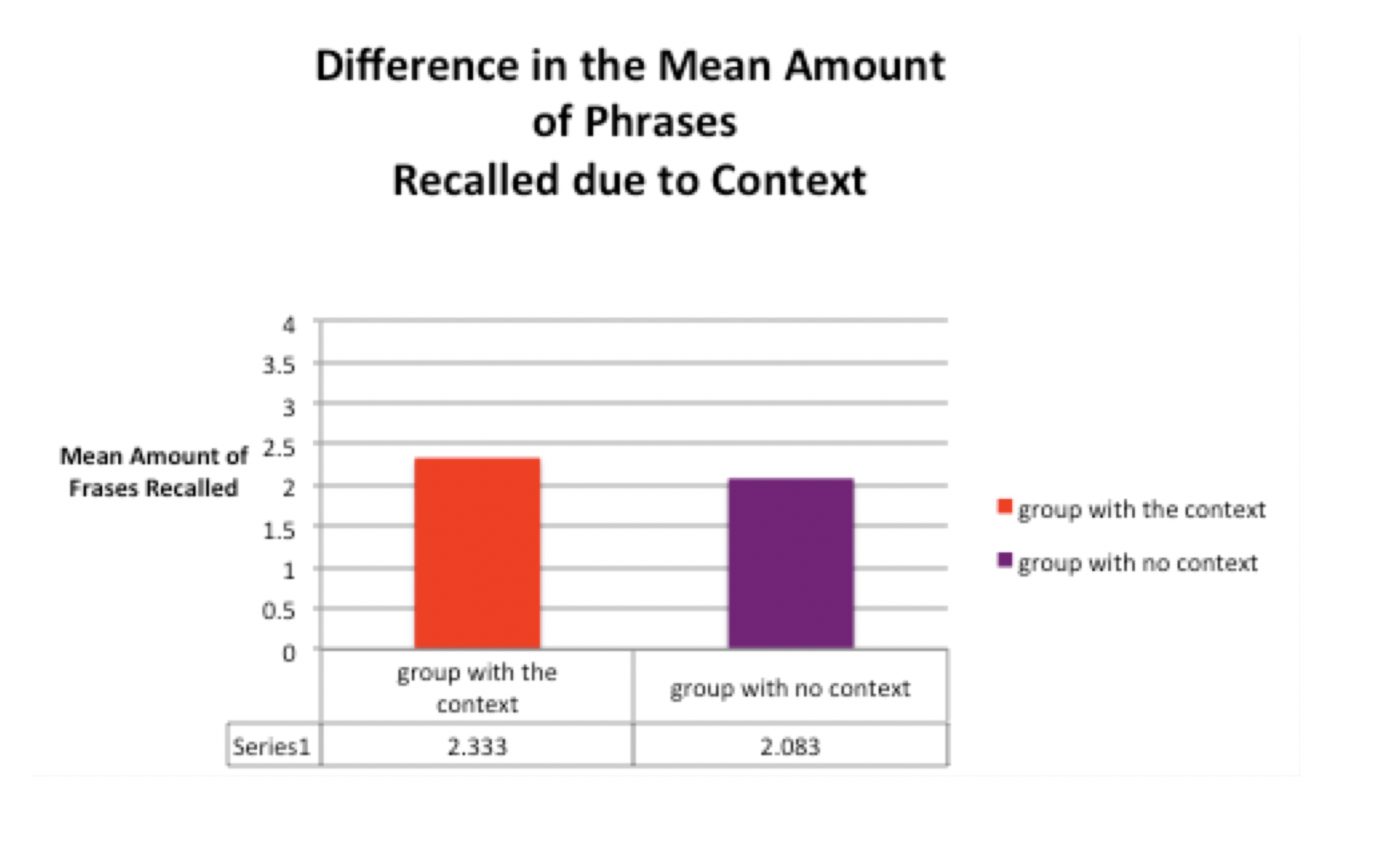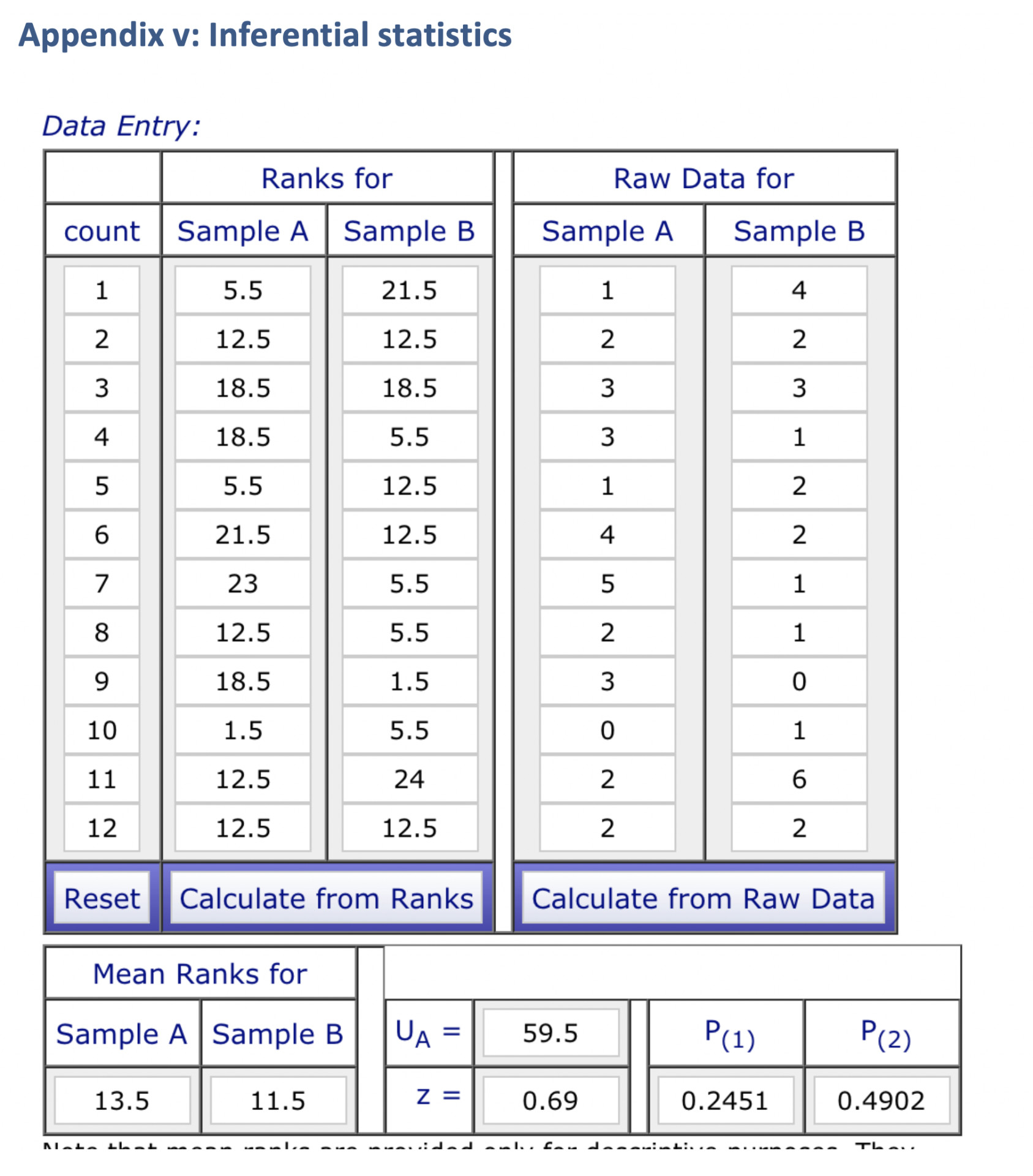IA marking: Sample 5
 The sample below is based on Bransford and Johnson's (1972) study of framing and memory recall.
The sample below is based on Bransford and Johnson's (1972) study of framing and memory recall.
The sample is based on a student's work, but is heavily edited and changes have been made to illustrate different facets of the IA.
The appendices do not include the letter of consent, materials, or the debriefing notes. The appendices do include the raw data and statistical calculations. Failure to include raw data or statistical calculations is penalized in the analysis.
Introduction
Schema theory states that memory is structured around schema. When retrieving episodic memories we are influenced by perceptions, past experiences and personal beliefs. Schemas decide which aspect of the experience we encode. Reconstructive memory is structured around the idea that memories aren’t saved entirely as coherent wholes, but rather in the form of snippets, which are directly influenced by our schemas. A schema is a mental representation, which is used to help us understand the world, and categorize information based on the relationship among them. Schemas are mental representation, which are created through our past experiences and knowledge gained from past experiences. Schemas allow our minds to simplify the world, as our brain interprets information in order to find the relevant schemas, which are appropriate to the situation. Schemas are used in multiple different ways, they organize the knowledge, which is gained from previous experiences, they guide our behaviour and help individuals make sense of every situation, which they find themselves in. Furthermore, scripts are patterns of behaviour, which originate from our interactions with the environment. As humans we have scripts for just about every situation, ranging from behaviour at school meetings to behaviour alongside friends at a party.
In the Bransford, J.D. & Johnson, M. K study, the participants were given a rather bizarre paragraph, which made very little sense in general. The participants were divided into four groups: one group was given only the paragraph, another was provided with a corresponding image before the paragraph, another group was provided with a corresponding image after the paragraph, and the last group only saw a part of the image before accessing the paragraph. The picture essentially represented a schema, as it served to help the participants remember parts of the story more clearly. As without it, the structure is lacking, and hence the participants were unable to remember much of the story presented in the paragraph. In the corresponding experiment, the participants were presented with another somewhat similar paragraph regarding something completely different. Participants were once again presented the paragraph in three groups, one third read the paragraph, one third was told that the paragraph was about the function of doing laundry, and the last third was given the context/topic of the paragraph after having heard it beforehand.
The target population for this experiment is international high school students. It will serve towards testing the participants' schemas. The participants will be separated into two groups, one will be given the image before the paragraph while the other won’t be given the image at all. Therefore, we will be comparing the reliability of their memories based on their access to encoded schemas, by providing access to the image alongside the paragraph.
The independent variable is the absence or presence of the context provided to a group of participants, in the form of an image. The dependent variable is the number of phrases that the participants are able to recall from the prose passage.
Research hypothesis: High school students will effectively use relevant schemas when presented with the context (visual) and recall information more accurately.
Null Hypothesis: The participants' ability to recall information will not be affected by the showing them an image.
Exploration
The experiment used an independent samples design, meaning that the participants were divided into two groups. The control group was given the audio recording of the passage, and the treatment group was provided with a visual alongside the audio recording. These steps were taken in order to prevent practice effect. Using the same participants in both conditions, wouldn’t be applicable, as they would learn what to remember from the first trial, which would directly influence the results in the second trial. The independent variable in this experiment was the availability of the visual alongside the audio recording. The dependent variable is the accuracy in the participants' ability to recall the information supplied through both methods in which the information was provided to the participants. The prose passage was recorded in order to ensure that the accent of the individual, as well as the speed of the recording, will not influence the participants' ability to recall.
A sample of opportunity was used, meaning that the sample was easily collected. The sample was made up of two homerooms of grade 10 students. There were 13 girls and 11 boys, and 24 participants involved in the experiment in total. In the context condition, there were 4 males and 7 females, whilst in the group without context, there were 7 males and 6 females.
All the participants were given a consent form, to fill out, before the experiment began.
Using an outsider's help, we created a voice message which read out the passage. The passage was read out by an outside figure, who is fluent with English, in order for the recording to be as clear as possible so that all the participants understood what was being said.
In order to randomly allocate the participants, we allowed them to pick numbers out of a hat. The number they picked, resulted in them splitting into two groups. They were randomly allocated into one of two conditions, a group without the image alongside the story, or a group with the image before the story. Whilst one group sat outside, out of hearing range. The other group was presented with an audible representation of the passage alongside the image. Participants from both groups were provided with a sheet, on which they wrote down the answers to the questions regarding their memories of the passage. All of the participants were informed that they were going to hear a recording of the passage and that they will be asked to recall the passage afterward and were asked to listen as carefully as possible. Furthermore, they were asked not to communicate with one another throughout the experiment at any point.
The group of participants with the image was provided 40 seconds in order to inspect and memorize as much of the image as possible. Whilst the other condition, without the image, had the opportunity to listen to the recorded passage twice, with 20-second breaks between the recordings. Before providing the participants with the data collection sheet, there was a minute-long delay.
Following the end of the audio recording of the passage, the answers sheets were collected and the participants were debriefed.
Analysis
The data consists of the participants' ability to recall information correctly, dependant on the amount of context they were provided. Participants were in two groups, a group with context and a group without context. The correlation between the participants' ability to recall parts of the prose paragraph, and the amount of context they were provided with was measured, and the results are as follows.
Table 1. Descriptive analysis of data
| Context group | No context group | |
| Mean | 2.33 | 2.08 |
| Standard deviation | 1.37 | 1.62 |

As we can see in the data above, it appears that the difference is very small between the two data sets. The difference between the number of applicable words, which the participants remembered from the prose passage between the group with the context, in this case, a visual alongside a recording of the prone passage, is 0.25. That certainly doesn’t signify a large difference between the two data sets, which encourages the perception that the context does not heavily influence the participants' ability to remember important factors of the prone passage. Both groups managed to recall a similar amount of words from the prone passage, which resulted in a point provided to the individual for recalling the passage effectively.
A Mann Whitney U test for the significance of the difference between the variance of the two samples indicated weak evidence against the null hypothesis. The calculated p-value is 0.24, which showed that the data is not significant. The Mann Whitney U test was used because there were two conditions in the experiment.
Evaluation
The results which we achieved are rather different compared with the results of the original Bransford & Johnson (1972) study. As mentioned in the writing above, the difference in results between the group with context compared to the group without context is barely evident. The mean number of phrases recalled is basically the same for both groups and it seems that the addition of context did not effectively influence the participants' ability to recall the presented information.
Schema theory states that memories are structured around schemas, and a schema is a mental representation that helps individuals recall and interpret information and behaviours. The visual image served the role of providing the context, alongside the story, which was aimed to help the participants activate relevant schemas in order to recall the information accurately. Our findings suggest, that the participants were just as successful in recalling information with or without a visual image. Although schema may lead to memory distortion, this does not appear to be the case in our study. Schema are a representation of one's culture and past experience.
A sample of opportunity was used meaning that it was very easily collectible. The sample was made up of two grade 10 homerooms in a high school.
The experiment followed an independent samples design, meaning the participants were divided into groups. The division of the classes into groups worked well and created a satisfactory amount of data. This created the possibility to randomly allocate the participants to groups, by picking numbers out of a hat.
A strength of our sample is that all of the participants included were fluent in the language which was studied. The prose passage was recorded separately, in order to ensure that its speed or language, wouldn’t affect the participants' ability to recall the information accurately.
We can conclude that the involvement of a visual, which provides context, influences an individual's ability to activate relevant schemas in order to recall relevant information.
Works cited
Bransford and Johnson (1972). Mixing memory in November. “My Favorite Experiments: Bransford and Johnson.” Starts With A Bang, scienceblogs.com/mixingmemory/2007/11/30/my-favorite-experiments-bransf/.
Appendix i. Raw data
| Context | No context |
| 1 | 4 |
| 2 | 2 |
| 3 | 3 |
| 3 | 1 |
| 1 | 2 |
| 4 | 2 |
| 5 | 1 |
| 2 | 1 |
| 3 | 0 |
| 0 | 1 |
| 2 | 6 |
| 2 | 2 |
Appendix ii. Mann Whitney calculations

Assessment
Introduction (max 6 marks)
The aim of the investigation is not stated and its relevance is not identified. The student refers to the "reliability" of memory, which is not what Bradsford et al were investigating (0 marks). There is an attempt to describe the theory on which the study is based, but there is only a limited link to the study (3 marks). Null and/or research hypotheses are stated, but do not correctly identify the independent or dependent variables. The hypotheses are not correctly stated (1 mark)
Total: 2 marksExploration (max 4 marks)
The research design is identified and there is an attempt to explain its use, but it could be more developed (3 marks) The sampling technique is described (2 marks). There are very few characteristics of the participants described. There is no indication of their age or native language, for example (1 mark). Controlled variables are described (2 marks). The materials are not well described or explained (1 mark).
Total: 2 marks
Analysis (max 6 marks)
Descriptive and inferential statistics are appropriately and accurately applied. (6 marks). A correct graph is chosen, but the data is distorted. It is not clear how many phrases there actually were, but there must have been more than four. The x-axis should show the full range of data (3 marks). There is no clear statemet of significance. There is very limited interpretation of the data or statistics (2 marks).
Total: 3 marks
Evaluation (max 6 marks)
Schema theory is described again, but there is only a superficial link to the experiment (2 marks). Lacks a coherent evaluation of the design, sample and procedure (1 mark). No modifications are identified or explained (0 marks).
Total: 1 mark
Total marks
There is no in-text citation for this sample. The moderator would flag this report for academic dishonesty.
Total marks: 8
IB score: 3

 IB Docs (2) Team
IB Docs (2) Team
